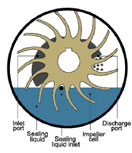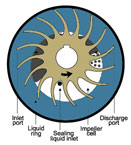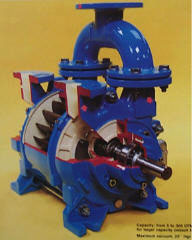Theory of Operation
A liquid ring vacuum pump has an impeller with blades attached to a center hub. The blades are located in the cylindrical body, but are off-set from the center.
In Figure 1 to the right, you can see the blades near the top of the pump are closer to the outside wall than at the sides and bottom of the pump. You can see this more clearly in Figure 2.
The impeller sits between two end plates (port plates) which have shaped holes cut into them called ports.
The pump requires a liquid (also called the sealant) to create vacuum as follows. Prior to starting, the pump is partially filled with the liquid sealant. The liquid can be water (making it a water ring pump), oil or a solvent, depending upon the application.



